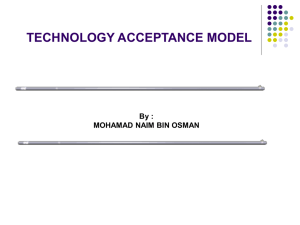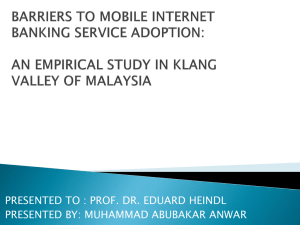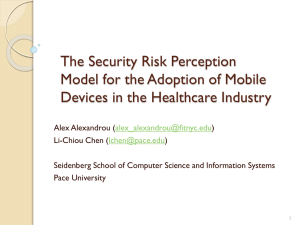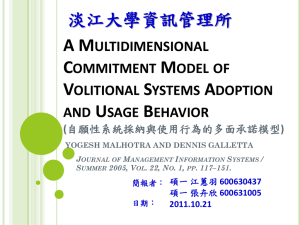Powerpoint Presentation
advertisement
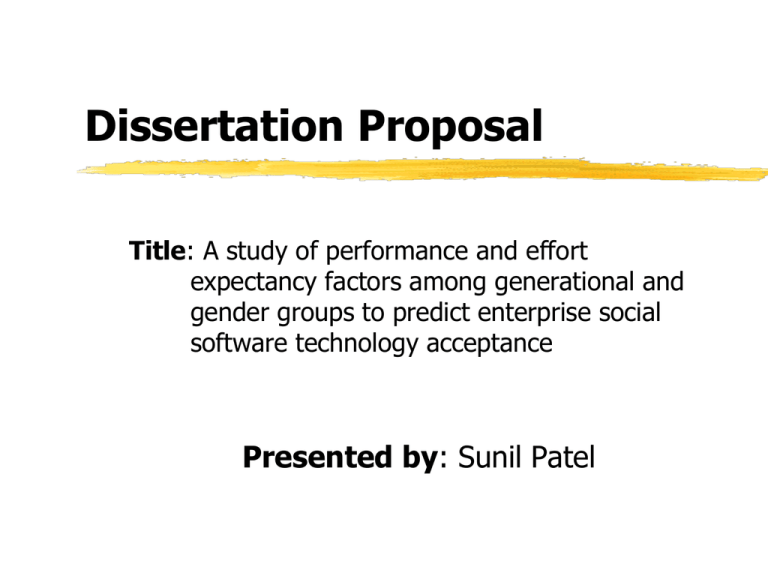
Dissertation Proposal Title: A study of performance and effort expectancy factors among generational and gender groups to predict enterprise social software technology acceptance Presented by: Sunil Patel Background / Need for the Study / Purpose of the Study Background: Social software usage in non-business contexts has risen significantly in the last decade Web 2.0 software technology gives rise to Enterprise Social Software (ESS) Companies across industries are increasingly investigating ESS – for usage in the context of business – to support business objectives such as enhancing employee productivity Need for the study: Technology adoption (acceptance) is a critical success factor to successful IT delivery Ample research literature exists on general technology acceptance, but little exists on IT managers’ perceptions of ESS technology acceptance Age and gender have shown differing patterns on technology acceptance Purpose of the study: Examine IT managers’ perceptions of ESS usefulness (PU), ease of use (PEOU), and behavioral intention (BI) to use ESS to determine if differences exist between the managers’, generations or gender types; or if relationships exist with age, gender 2 Pg. 1-11 Link: Detailed Hypotheses Research Questions 1. IT Acceptance Factors: Is there a relationship between variables of IT managers' behavioral intention to use ESS, perceived usefulness, and perceived ease of use? Is there a moderating variable? 2. Age: Is there a relationship or difference between IT managers' age and generational groups and the variables of perceived usefulness, perceived ease of use, and behavioral intention to use ESS? 3. Gender: Is there a relationship or difference between IT managers' gender and the variables of perceived usefulness, perceived ease of use, and behavioral intention to use ESS? 4. All variables: Is there a relationship or difference between IT managers' behavioral intention to use ESS and the variables of age, generation, gender, perceived usefulness, and perceived ease of use? 3 Pg. 11-12 Link: Theoretical Model Link: Variables / Analyses Literature Review IT Acceptance Factors: Perceived usefulness (PU), Perceived Ease of Use (PEOU), and Behavioral Intention (BI) to use ESS Studies indicate individuals are more apt to use technology to the extent it will (a) increase performance through usefulness and (b) decrease effort required through ease of use Technology acceptance factors in the context of IT / social software Social software: Lane & Coleman, 2011; Wattal, Racherla & Mandviwalla, 2009 General IT and voluntariness: Brown, Massey, Montoya-Weiss & Burkman, 2002 IT and productivity enhancement: Lehr & Lichtenberg, 1999 Age and Generational Groups / Technology Acceptance Aging workforce as a business dynamic Studies indicate differing IT acceptance patterns among generational groups Generational cohort-groups theorized to have differing patterns of identifying traits (Strauss & Howe, 1994) Online communities and ubiquitous technologies (Chung et al., 2010) Other studies supporting age as moderating factor in IT acceptance decisions (Morris & Venkatesh, 2000; Morris, Venkatesh & Ackerman, 2005) 4 Pg. 16-22 Link: Theoretical Model Link: Variables / Analyses Literature Review, cont. Gender Types / Technology Acceptance One of the first studies on the influence of gender on IT acceptance factors performed just over 14 years ago Research supports gender differences with general technology acceptance although little empirical data exists in context of enterprise social software Gender differences on acceptance of e-mail technology (Gefen & Straub, 1997) Differing salience to technology usage and ease of use between gender types (Minton & Schneider, 1980; Morris, Venkatesh & Ackerman, 2005; Venkatesh & Morris, 2000; Wattal, Racherla & Mandviwalla, 2009) 5 Pg. 22-23 Link: Theoretical Model Link: Variables / Analyses Methodology Correlation-research design IT managers in the U.S. are in scope for this study Population consists of over 288,000 IT Managers (U.S. BLS, 2010) Sample size of 384 necessary based on alpha set to .05 and power set to .80 Instrumentation Perceived Usefulness & Ease of Use scale (Adapted from Venkatesh & Davis, 1996) Item grouping and analysis did not indicate artificial inflation or deflation of reliability / validity (Davis, Bagozzi & Warshaw, 1989; Davis & Venkatesh, 1996) Validity and reliability are consistent through numerous replication studies Adams, Nelson & Todd 1992; Davis, Bagozzi & Warshaw, 1989; Hendrickson, Massey & Cronan 1993; Igbaria & Iivari, 1995; Segars & Grover 1993; Subramanian, 1994; Szajna, 1994 Reliability: Cronbach’s alpha remained at over .90 in above listed studies Validity: High discriminant / factorial validity as measured by correlation coefficient (r) 6 Pg. 26-31 Link: Theoretical Model Link: Variables / Analyses Link: Detailed Hypotheses Methodology, cont. Data Collection Procedures Online panel research survey firm to collect data (e.g. ResearchNow, Qualtrics) Recruitment email sent to panel participants meeting the criteria specified for study’s population (i.e. IT managers in U.S.) Survey open 45 days or until minimum number of valid responses received Data Analysis Independent and Dependent Variables List (Reference Table 4, p. 34) Run data for descriptive, inferential, and multivariate analyses Tests of statistical significance (significant at p < .05) Pearson’s r (Ho1a, Ho1b, Ho2a, Ho3a, Ho4a) Wilk’s Lambda for MANOVAs (Ho2b, Ho3b, Ho4b) 7 Pg. 32-42 Status and Next Steps Human Subjects Approval Status IRB Approval granted on April 19, 2012 (No. 12-192) Next Steps Proceed with online panel research survey firm to publish informed consent notice and instrument items Collect data, complete Chapters 4 and 5 Review, schedule dissertation defense (July) Seek publication Option 1: Performance Improvement Quarterly (PIQ) Option 2: Human Resource Development Quarterly (HRDQ) 8 Backup 9 Link: Literature Review Link: Methodology Link: Variables / Analyses Theoretical Framework 10 Pg. 33 Link: Literature Review Link: Methodology Link: Theoretical Model Hypotheses Analysis and Variable Types 11 Pg. 33 Link: Literature Review Hypotheses Analysis and Variable Types, cont. 12 Link: Methodology Link: Theoretical Model Pg. 34 Link: Literature Review Hypotheses Analysis and Variable Types, cont. 13 Link: Methodology Link: Theoretical Model Pg. 35 Link: Research Questions Link: Methodology Link: Theoretical Model Research Questions and Hypotheses 1. Is there a relationship between variables of IT managers' behavioral intention to use ESS technology, perceived usefulness, and perceived ease of use? Ho1a: There is no statistically significant relationship between IT managers' perceived behavioral intention to use ESS technology and variables of perceived usefulness and perceived ease of use. Ho1b: IT managers' perceived ease of use is not positively related to perceived usefulness. 2. Is there a relationship or difference between IT managers' age and generational groups and the variables of perceived usefulness, perceived ease of use, and behavioral intention to use ESS technology? Ho2a: There is no statistically significant relationship between IT managers' behavioral intention to use ESS technology and the variables of perceived usefulness, perceived ease of use, and age. Ho2b: There is no statistically significant difference between IT managers' generational groups and the variables of perceived ease of use, perceived usefulness, and behavioral intention to use ESS technology. 14 Pg. 11-12 Link: Literature Review Link: Methodology Link: Theoretical Model Research Questions and Hypotheses, cont. 3. Is there a relationship or difference between IT managers' gender and the variables of perceived usefulness, perceived ease of use, and behavioral intention to use ESS technology? Ho3a: There is no statistically significant relationship between IT managers' behavioral intention to use ESS technology and the variables of perceived usefulness, perceived ease of use, and gender. Ho3b: There is no statistically significant difference between IT managers' gender and the variables of perceived ease of use, perceived usefulness, and behavioral intention to use ESS technology. 4. Is there a relationship or difference between IT managers' behavioral intention to use ESS technology and the variables of age, gender, perceived usefulness, and perceived ease of use? Ho4a: There is no statistically significant relationship between IT managers' behavioral intention to use ESS technology and the variables of perceived usefulness, perceived ease of use, age, and gender. Ho4b: There is no statistically significant difference between IT managers' generational groups and gender types and the variables of perceived usefulness, perceived ease of use, and behavioral intention to use ESS technology. 15 Pg. 12
